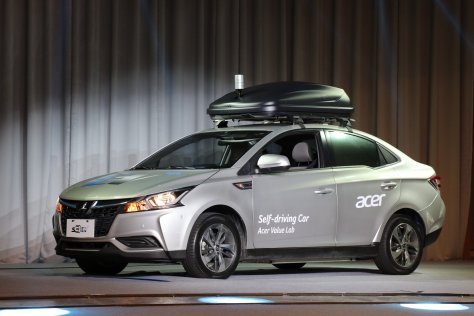 Acer has unveiled its self-driving concept car at the Taiwan Automotive Technology Innovation Summit 2018, in collaboration with Yulon Group, one of Taiwan’s top automakers and its subsidiaries automotive electronics provider HAITEC and car brand Luxgen.
Acer has unveiled its self-driving concept car at the Taiwan Automotive Technology Innovation Summit 2018, in collaboration with Yulon Group, one of Taiwan’s top automakers and its subsidiaries automotive electronics provider HAITEC and car brand Luxgen.
Integrating Acer’s autonomous driving system with the Luxgen S3 electric vehicle platform, the two companies demonstrated their level 4-ready self-driving concept car, showcasing their shared vision of AI (artificial intelligence) and autonomous driving technology.
“Both the automotive and ICT industries are going through a paradigm shift; automation, connectivity, electrification, and ‘servicification’ are key trends of future development,” said Edward Lin, associate vice president, Value Lab, Acer Inc. “In the realm of smart transportation, Acer already has a foothold in electronic ticketing, smart parking, connected car, and traffic prediction, and we’re excited to work with Yulon Group to venture into self-driving cars.”
[For more stories about the upcoming GITEX Technology Week subscribe to our newsletters. ]
Lin also added, “With Acer’s strength across software, hardware, and services, we’re in a great position to leverage our AI technology and fulfill the vision of Mobility as a Service (MaaS).”
“Autonomous driving is the future trend of the automotive industry, manufacturers around the world are stepping up from level 2 autonomous driving to level 3 and 4,” said Jung-Kuei Chen, VP, Product Engineering Group II, HAITEC. “With Acer, we’ve jointly unveiled Taiwan’s first self-driving concept car with ADAS (Advanced Driver Assistance Systems), IoV (Internet of Vehicles) and autonomous driving technology. Integrating Acer’s expertise in AI and the cloud with HAITEC’s self-developed open vehicle platform, we’ve achieved so much through our cross-industry collaboration.”
The level 4-ready self-driving concept car is based on the Luxgen S3 electric vehicle platform, with Acer’s autonomous driving system encompassing sensing, decision-making and control. Acer’s self-driving system leverages AI and sensor fusion algorithms fed with data from real-time kinematic (RTK) positioning, cameras, Lidars, MMW radars, IMU (inertial measurement unit) and ultrasonic sensors.
It also uses deep learning technology to conduct object recognition, and then implements dynamic vehicle control to realize autonomous driving.
Acer said its self-driving system makes dynamic vehicle control decisions through AI models based on key data including image recognition, 3D Lidar obstacle detection, high-precision maps and real-time positioning to help the car steer, brake, cruise, maneuver, or park. It also has a cloud management system for car sharing services so that a control centre can dispatch vehicles when users make transportation requests through their mobile device. The cloud management system can manage scheduling, monitoring, notification, and reporting, and allows safety monitoring and human intervention.
In the future, Acer said its self-driving system can enable multiple levels of autonomous driving, with plans to open the platform to partners and developers to collaborate on next-generation self-driving services.





